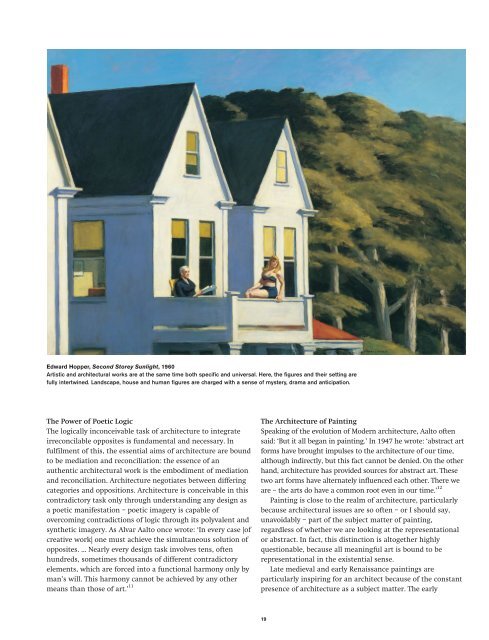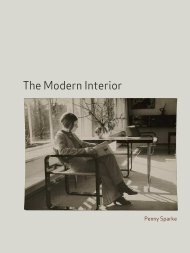Landscape Architecture: Landscape Architecture: - School of ...
Landscape Architecture: Landscape Architecture: - School of ...
Landscape Architecture: Landscape Architecture: - School of ...
- No tags were found...
You also want an ePaper? Increase the reach of your titles
YUMPU automatically turns print PDFs into web optimized ePapers that Google loves.
Edward Hopper, Second Storey Sunlight, 1960<br />
Artistic and architectural works are at the same time both specific and universal. Here, the figures and their setting are<br />
fully intertwined. <strong>Landscape</strong>, house and human figures are charged with a sense <strong>of</strong> mystery, drama and anticipation.<br />
The Power <strong>of</strong> Poetic Logic<br />
The logically inconceivable task <strong>of</strong> architecture to integrate<br />
irreconcilable opposites is fundamental and necessary. In<br />
fulfilment <strong>of</strong> this, the essential aims <strong>of</strong> architecture are bound<br />
to be mediation and reconciliation: the essence <strong>of</strong> an<br />
authentic architectural work is the embodiment <strong>of</strong> mediation<br />
and reconciliation. <strong>Architecture</strong> negotiates between differing<br />
categories and oppositions. <strong>Architecture</strong> is conceivable in this<br />
contradictory task only through understanding any design as<br />
a poetic manifestation – poetic imagery is capable <strong>of</strong><br />
overcoming contradictions <strong>of</strong> logic through its polyvalent and<br />
synthetic imagery. As Alvar Aalto once wrote: ‘In every case [<strong>of</strong><br />
creative work] one must achieve the simultaneous solution <strong>of</strong><br />
opposites. … Nearly every design task involves tens, <strong>of</strong>ten<br />
hundreds, sometimes thousands <strong>of</strong> different contradictory<br />
elements, which are forced into a functional harmony only by<br />
man’s will. This harmony cannot be achieved by any other<br />
means than those <strong>of</strong> art.’ 11<br />
The <strong>Architecture</strong> <strong>of</strong> Painting<br />
Speaking <strong>of</strong> the evolution <strong>of</strong> Modern architecture, Aalto <strong>of</strong>ten<br />
said: ‘But it all began in painting.’ In 1947 he wrote: ‘abstract art<br />
forms have brought impulses to the architecture <strong>of</strong> our time,<br />
although indirectly, but this fact cannot be denied. On the other<br />
hand, architecture has provided sources for abstract art. These<br />
two art forms have alternately influenced each other. There we<br />
are – the arts do have a common root even in our time.’ 12<br />
Painting is close to the realm <strong>of</strong> architecture, particularly<br />
because architectural issues are so <strong>of</strong>ten – or I should say,<br />
unavoidably – part <strong>of</strong> the subject matter <strong>of</strong> painting,<br />
regardless <strong>of</strong> whether we are looking at the representational<br />
or abstract. In fact, this distinction is altogether highly<br />
questionable, because all meaningful art is bound to be<br />
representational in the existential sense.<br />
Late medieval and early Renaissance paintings are<br />
particularly inspiring for an architect because <strong>of</strong> the constant<br />
presence <strong>of</strong> architecture as a subject matter. The early<br />
19



